6.4 Timber and concrete upper floors
SITEWORK STANDARDS
(a) meet the Technical Requirements
(b) take account of the design
(c) follow established good practice and workmanship
Sitework that complies with the design and the guidance below will be acceptable for timber and concrete upper floors.
TIMBER FLOORS
Items to be taken into account include:
(a) grades and sizes
Check materials on delivery to site for conformity with the drawings and specification.
Structural timber should be marked to show its strength class (normally C16 or C24). Alternatively, evidence of species and grade should be available to determine the equivalent strength class.
Where timber is graded to BS 4978 or BS EN 519, it should also be marked with identification of the company responsible for the grading.
Storage time may be minimised by phasing deliveries to suit the work programme. When storage is required, timber should be stored on bearers or in racks and be protected.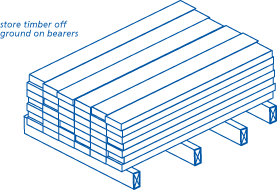
I-joists and metal web joists should be protected from adverse weather conditions during transport and storage. They should be stored clear of the ground and stacked vertically. Manufacturers' recommendations for handling, transport and storage should be followed. Damaged joists should not be used.
(b) moisture content
Structural softwood for internal use should be dry graded to BS 4978 or BS EN 519 and marked 'DRY' or 'KD'.
(c) quality
Timber should not be used if it:
- is excessively bowed, twisted or cambered
- has large edge knots or shakes
- has a wany edge more than half the thickness
- has any sign of rot
- has been damaged.
(d) bearing
Bearings for joists should be as follows;
| Type of timber joist |
Minimum bearing [mm] | |
| End support | Intermediate support | |
| Solid joist on masonry walls | 90 (75) | 90 (75) |
| Solid joist on timber wall plate | 75 | 75 |
| I-joist | 90 (45) | 90 |
| Metal web joist | 90 (75) | 90 |
Note
Figures in brackets should only be used when the joist is not providing restraint to the wall.
Bearings should be level. If joists are not laid level, the floor will be springy and uneven. Where bearings are uneven, joists should be levelled using hard packing, eg tiles or slates bedded in mortar. Loose or soft packing should not be used.
For further information concerning timber framed construction, reference should be made to Chapter 6.2 'External timber framed walls'.
(e) levelling
Where possible, regularised timber should be used.
The floor should be levelled from the staircase trimmer and trimming joist.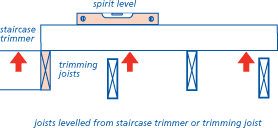
(f) joist spacings
Joist spacing should be as shown on the drawings. If the joist spacing is not shown, the designer should provide spacing details. Do not increase the spacing. Joists should not be spaced at more than 600mm centres. The decking material to be used should be taken into account.
(g) clearance from the wall
When placing joists, a clearance of 25mm to 75mm should be allowed between the first joist and the wall face. This helps when installing services and fixing floor decking.
JOIST HANGERS
It is important that the joist hanger is the correct size for the joist or trimmer.
For solid timber joists and metal web joists the hanger should be the full depth of the joists. A timber upright should be fixed between the flanges of metal web joists.
For I-joists the depth of the hanger should be at least 0.6 x the depth of the joist. Full depth stiffeners should be fixed to both sides of the web if the hanger does not restrain the top flange of an I-joist.
Where joist hangers are supported on lightweight blockwork, the suitability of the hanger should be checked. Joist hangers which meet BS EN 845 are stamped on the base or gusset with the minimum compressive strength of block for which they are suitable, eg 2.9N/mm2 or 3.6N/mm2. Where hangers are to BS EN 845-1 ensure the supporting masonry is that specified in the design.
Joist hangers should be supported on level beds and should be tight to the wall.
The masonry course to carry the joist hangers should be checked for level and height. Hangers should not be cut into the walling.
Where restraint type joist hangers are shown in the design do not use alternatives without checking with the designer.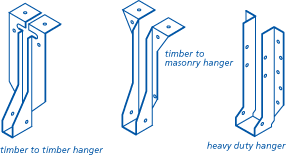
Joists should be accurately cut to length for a tight fit. Solid joists should be notched into the hanger to keep the ceiling line level.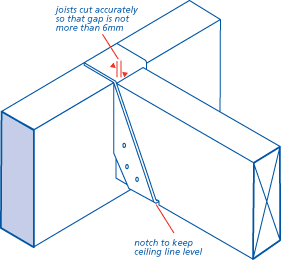
Flanges of I-joists should not be notched. Tabs of the hanger should be bent and nailed to the bottom flange of the I-joist.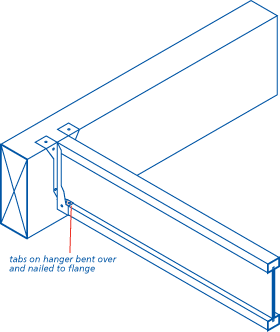
Flanges of metal web joists should not be notched. When used with hangers the top flange of metal web joists should be restrained.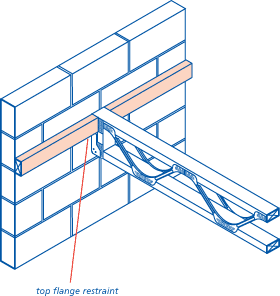
All circular holes in the vertical sides of joist hangers should be fully nailed.
When joist hangers are used at both ends of a joist, measuring, marking and cutting should be accurate to ensure the joist fits properly at both ends.
TRIMMED AND TRIMMING JOISTS
Trimmed and trimming joists should be used as detailed in the design.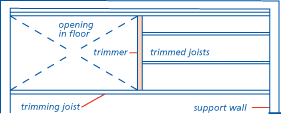
The thickness and depth of trimmed and trimming joists should be as detailed in the design.
The ends of trimmed solid joists may be supported using joist hangers or notches. When using hangers, 'timber-to-timber' hangers should be used, not wall hangers.
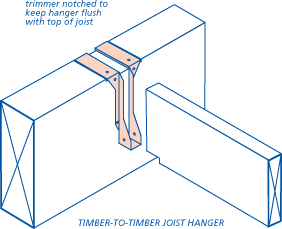
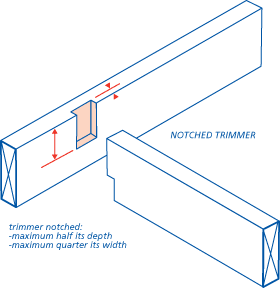
For lightly loaded trimmed joists, support battens (plates) may be used.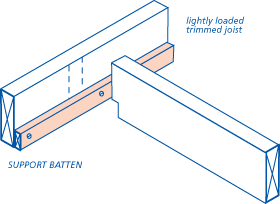
Flanges of I-joists should not be notched and should be supported on trimmers by 'timber-to-timber' hangers. Timber blocking should be used to face fix a joist to a trimmer joist.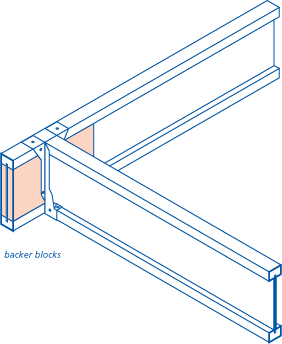
Flanges of metal web joists should not be notched and 'timber-to-timber' hangers should be used to join a joist to a trimmer joist.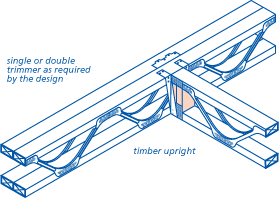
Joists trimmed into steelwork should be notched at both top and bottom and have 12mm/2mm projections respectively to allow for timber shrinkage.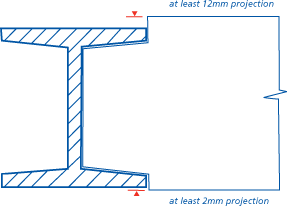
Flanges of I-joists should not be notched. I-joists can bear directly into the steel beam if there is at least 45mm bearing on the bottom flange of the steel beam and noggings (38mm x thickness of flange) should be provided at the top and bottom flanges of the I-joists. If the bearing is less than 45mm timber blocking should be fixed to the steel beam to enable the I-joists to be face fixed using joist hangers to the blocking inside the steel beam.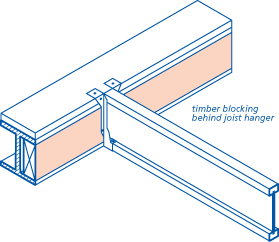
Flanges of metal web joists should not be notched. Joists can bear directly into the steel beam if there is at least 75mm bearing on the bottom flange of the steel beam. Timber uprights should be provided between the flanges and 38mm x 97mm noggings should be provided between the uprights. If the bearing is less than 75mm metal web joists can be supported on their top flange and their bottom flange should be fixed to timber blocking supported inside the steel beam.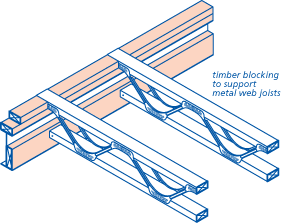
MULTIPLE JOISTS
Solid timber joists may be doubled up to support a non-masonry partition or to form trimmers.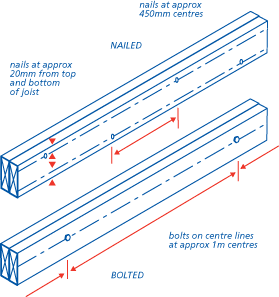
Fixings should be to the Engineer's specification and should be given a second check for tightness just before fixing the ceiling.
Toothed plate, split ring and shear plate connectors should be used in strict accordance with manufacturers' recommendations.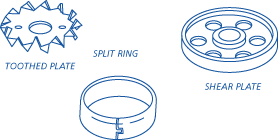
Washers, or single faced connectors, should be used with bolts. Check whether toothed connectors are required between the timber faces. Ensure that all washers, etc are provided.
Bolts should be checked for tightness (fixing bolts should not be used for tightening). Make sure that timber is not damaged by over-tightening.
I-joists can be doubled or tripled up in accordance with manufacturer's recommendations to support a lightweight partition or to form trimmers. The design should specify how the joists are fixed together.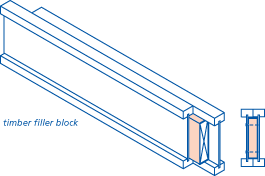
STRUTTING OF FLOOR JOISTS
Items to be taken into account include:
(a) span of the floor
Strutting for solid timber joists should be provided before laying floor decking as follows:
| Joist span [m] | Rows of strutting |
| Up to 2.5 | none needed |
| 2.5 to 4.5 | 1 (at centre of span) |
| Over 4.5 | 2 (at equal spacing) |
For solid timber joists either herringbone strutting (38mm x 38mm timber) or minimum 38mm thick solid strutting should be used, for not less than three-quarters the depth of the joist. Strutting should not project beyond the top and bottom edges of joists.
At the end of each run of strutting the last joist should be firmly blocked to the wall.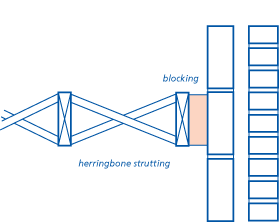
Where I-joists require strutting it should be provided in accordance with the table for solid timber joists.
Where metal web joists require strutting it should be in accordance with the following table:
| Joist span [m] | Rows of bracing |
| 4.0 to 8.0 | 1 (at centre of span) |
| Over 8.0 | 2 (at equal spacing) |
For metal web joists, bracing (strongbacks) should be provided.
(b) bearings onto steelwork
Strutting should be provided where solid timber joists bear on, or are notched into, steelwork to prevent rotation.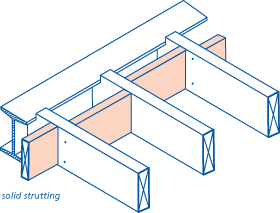
Strutting should be provided where I-joists bear directly onto the bottom flange of the steel beam. Noggings (38mm x thickness of flange) should be provided at the top and bottom flanges of the I-joists. Strutting is not necessary when an infill timber blocking is fixed to the steel beam and joists hangers of full depth of the joists are used to face fix the joists to the blocking.
Strutting should be provided where metal web joists bear directly on to the bottom flange of the steel beam. Timber uprights should be provided between the flanges and 38mm x 97mm noggings should be provided between the uprights.
(c) joists supported by hangers
Solid blocking should be used at all joist bearings of solid timber joists where they are not built into brickwork or blockwork. This includes some forms of timber frame construction. The blocking may be used for fixing plasterboard and floor decking.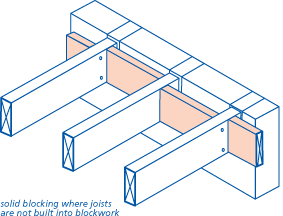
(d) I-joists and metal web joists supported on walls
Noggings should be provided for I-joists and metal web joists at the top flange along the wall to support the floor decking. Noggings at the bottom flange may be required to support the plasterboard ceiling.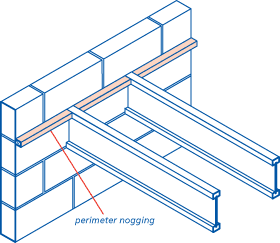
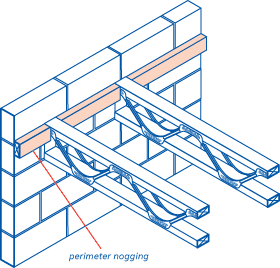
NOTCHING AND DRILLING
Items to be taken into account include:
(a) solid timber joists
Solid timber joists and studs should only be notched and drilled within the limits shown in the table below:
| Item | Location | Maximum size |
| Notching joists up to 250mm depth |
Top edge 0.1 to 0.2 of span | 0.15 x depth of joist |
| Drilling joists up to 250mm | Centre line 0.25 to 0.4 of span | 0.25 x depth of joist |
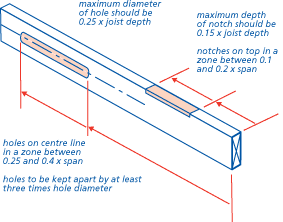
Notches and drillings in the same joist should be at least 100mm apart horizontally.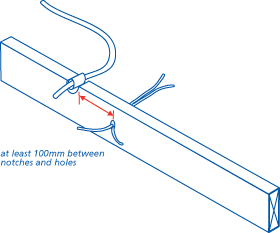
Special instructions should be obtained from the designer when notching and drilling:
- is required in joists deeper than 250mm
- does not meet the above guidelines, or
- is needed close to heavy loads, such as those from partitions, cisterns, cylinders and stair trimming.
If structural strength is impaired by notching or drilling, the element should be replaced or correctly repaired.
(b) I-joists
In I-joists pre-formed holes are provided in the timber webs for pipes and cables. Other holes or notches should not be cut without the approval of the manufacturer. However, restraint straps can be slotted into webs immediately below the top flange.
(c) metal web joists
In metal web joists service conduits should run in the gaps between the metal webs. The maximum duct sizes should be in accordance with the manufacturer's recommendations. Large service ducts may have to be inserted before fixing the joists as it may not be possible after the joists have been fixed.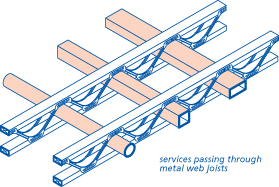
RESTRAINT STRAPPING
When the external wall is to be stabilised by connection to the floor, straps may be required. They may be fixed to the top or bottom of the joist, depending on how the masonry is coursed.
Straps should have a cross section of 30mm x 5mm galvanised steel straps or straps which have been assessed in accordance with Technical Requirement R3. (See clause 6.4 - S12 for fixing details).
Where joists run parallel to the wall, straps should be supported on noggings fixed between the three joists adjacent to the wall.
Solid timber joists should have noggings not less than 0.5 times the depth of the joists if the strap is located on top of the joists but the full depth if located beneath the joists.
I-joists should have solid timber noggings not less than 0.5 times the depth of the I-joists up to a maximum of 150mm, fixed between the webs and located beneath the top flange of the I-joists when 30mm x 5mm galvanised straps are used. Where straps which have been assessed in accordance with Technical Requirement R3 are used the noggings should be short lengths of I-joist or solid timber noggings to the full depth of the I-joists.
Metal web joists should have solid timber noggings, size 35mm x 97mm, used beneath the top flange of the metal web joists and twice nailed to the joists.
Straps should be placed at a maximum of 2m apart and carried over the three joists. Packing should be provided between the wall and the first joist.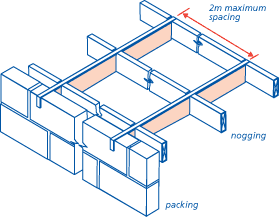
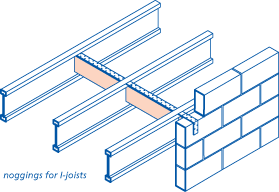
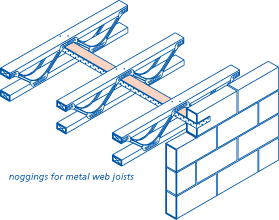
In buildings of not more than two storeys where joists are supported on walls, restraint straps will not normally be required at the ends of joists, if there is at least 90mm bearing (eg if they are built into masonry).
Separate straps should be fitted along the joists and at centres not more than 2m unless the joist hangers are designed to provide restraint.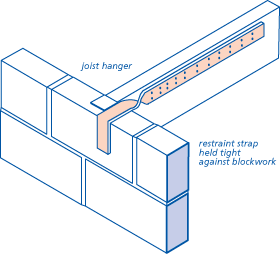
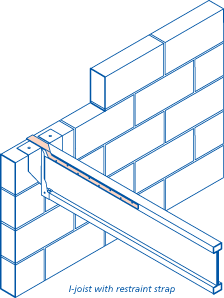
Straps should bear on the centre of bricks or blocks, not on mortar joints.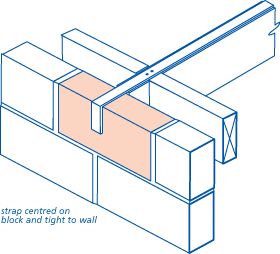
Straps may be fixed on the side, top or bottom as appropriate for all joist types. I-joists and metal web joists should not be notched.
Straps to walls which run parallel to the joists should extend over at least three joists. They should be fixed with 2 screws or nails into each joist. The fixings should be 3.75mm x 30mm square twisted nails for all joist types. Noggings should be provided to receive two additional nails. Alternatively for solid joists two 4.76mm diameter x 50mm long wood screws (No. 10) or 4mm diameter x 75mm round nails (8 SWG) can be used in each joist.
When nailing into Laminated Veneer Lumber flanges of I-joists, care should be taken to prevent the splitting of the flanges. Nails should be driven in at an angle (not horizontally) and should not protrude from the flanges.
OVERLAPPING AND BUTTED JOISTS
Items to be taken into account include:
(a) solid timber joists
Where joists overlap on loadbearing intermediate walls, they should be nailed together and cut so that they will not project beyond the supporting wall by more than 100mm. This is to prevent the floor decking being pushed up or the ceiling being cracked when the cantilevered part of the joist moves upwards.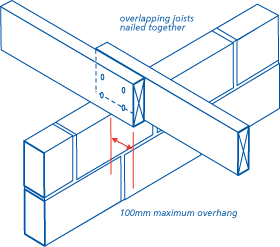
(b) I-joists
Where I-joists are supported on load bearing intermediate walls they should be fixed as follows: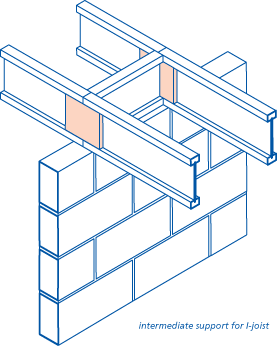
(c) metal web joists
Where metal web joists are supported on load bearing intermediate walls they require a minimum bearing of not less than 90mm. Joists should be overlapped. Blocking is required between the joists unless walls are built up to the underside of the floor.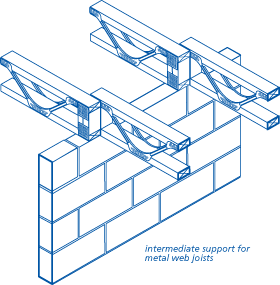
FLOOR DECKING : GENERAL
Timber based materials can swell if they become wet and may twist and bow producing large gaps when drying out. If timber decking is installed before the dwelling is substantially watertight the manufacturer should confirm that it is suitable for that situation.
When floor decking has to be stored, it should be stored on a hard base, under cover, if possible indoors.
Before fixing floor decking, a check should be made that all noggings, blocking and strutting are in place and fixed securely.
The length of nails should be 2½ times the thickness of the decking.
The ends of adjacent boards should be square. Joints should be staggered and supported on noggings or joists. Reference should be made to Clause S23 for fixing floating floors.
Temporary wedges and packings at the perimeter should be removed after the floor decking is complete.
Floors should not be overloaded, especially with materials stored during construction. Where necessary, fixed flooring and/or floor decking should be protected against damp (for example from plaster splashes) and damage.
SOFTWOOD BOARDING
End (butt) joints should be made on joists and staggered, ie the joints of adjacent boards should not be on the same joist.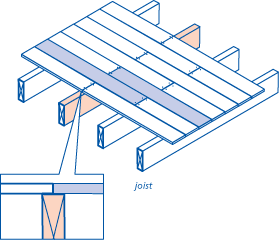
Board thickness should not be less than the following for the joist spacings indicated:
| Board thickness [mm] | Maximum joist centres [mm] |
| 16 | 450 |
| 19 | 600 |
Boards should be cramped up and either double nailed or secret nailed to each joist. Nails should be of a length 2½ times the thickness of the decking and should be punched well below the surface.
The above thicknesses may not be adequate to achieve a mass for floor boarding of 15 kg/m2 for sound insulation requirements of floors in England & Wales.
CHIPBOARD FLOORING
Only moisture-resistant, Type P5 chipboard to BS EN 312 should be used for flooring. This can be recognised by the green stripe on the chipboard edge and an identifying marking.
Board thicknesses should be not less than the following for the joist spacings indicated:
| Board thickness [mm] | Maximum joist centres [mm] |
| 18/20 | 450 |
| 22 | 600 |
The above thicknesses may not be adequate to achieve a mass for floor decking of 15 kg/m2 for sound insulation requirements of floors in England & Wales.
ALL TYPES OF CHIPBOARD
Chipboard should be supported and fixed in accordance with manufacturers' instructions, using either:
- flat-headed ring shank nails minimum 3mm diameter and of length 2½ times the thickness of the chipboard, or
- screws, to BS 1210 with a minimum length of twice the board thickness and not less than size no. 8.
Edges at room perimeters should be supported on joists or noggings.
Fixings should be spaced at centres not more than 300mm apart along the continuously supported edges and the intermediate supports.
Expansion gaps should be not less than 10mm wide where boards abut a rigid upstand. For larger areas of boarded floor a wider gap may be needed at upstands and intermediate expansion gaps equal to 2mm per linear metre of floor provided.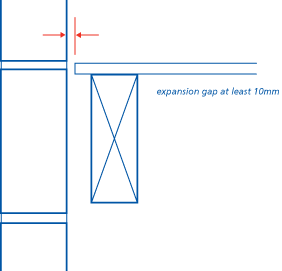
SQUARE EDGED BOARDS AND BOARDS WITH LOOSE TONGUES
Boards should be supported on all sides on joists or noggings.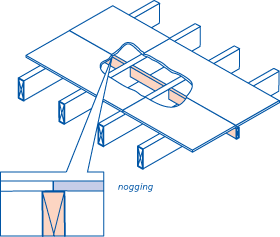
TONGUED AND GROOVED BOARDS
Boards should be laid with long edges at right angles to joists.
Short edges should be supported on joists or noggings.
Projecting ends of boards should be cut back to form a butt joint on a joist.
To reduce squeaking, tongued and grooved joints between boards should be glued and the boards should be glued to the joists. A suitable polyvinyl acetate (PVAC) adhesive should be used.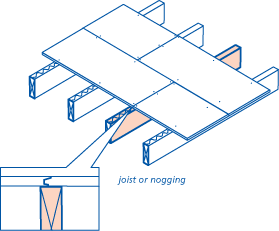
ORIENTED STRAND BOARD FLOORING
Oriented strand board should be laid over supports in the direction indicated on the boards. The stronger axis should be laid at right angles to the supporting joists.
All square edges should be supported. All short edges should be supported on the centre line of the joist. It is not necessary to support the long edges of tongued and grooved boards, except at room perimeters where all board edges should be fully supported.
No boards less than two joist spacings long should be used.
Nails should be flat headed, annular grooved nails 3mm in diameter.
Expansion gaps should be not less than 10mm wide where boards abut a rigid upstand. For larger areas of boarded floor a wider gap may be needed at upstands and intermediate expansion gaps equal to 2mm per linear metre of floor provided.
To reduce squeaking, tongued and grooved joints between boards should be glued and the boards should be glued to the joists. A suitable polyvinyl acetate (PVAC) adhesive should be used.
PLYWOOD FLOORING
Plywood should be laid with the face grain at right angles to the supports. All butt joints and joints with loose tongues should be supported on joists or noggings. All end joints should occur over joists (38mm minimum thickness) or noggings.
Board thickness should be not less than the following for the joist spacings indicated:
| Board thickness [mm] | Maximum joist centres [mm] |
| 12 | 450 |
| 16 | 600 |
The above thicknesses may not be adequate to achieve a mass for floor decking of 15 kg/m2 for sound insulation requirements of floors in England & Wales.
Nails for fixing plywood should be either:
- plain wire nails - minimum diameter 3.35mm
- minimum length 65mm
- with penetration not less than 40mm, or
- annular-ring shank nails - minimum diameter 3mm
- minimum length 50mm
- penetration not less than 32mm.
Fixings should be at 150mm centres (max) around the perimeter and 300mm centres (max) on intermediate supports.
An expansion gap of at least 1.5 - 2mm should be allowed between each panel.
OTHER FLOOR DECKING
Proprietary floor decking should be assessed in accordance with Technical Requirement R3 and be fixed in accordance with any certification requirements.
FLOORS BETWEEN DWELLINGS
The structural component of floors between dwellings may be concrete, steel, timber or a combination of these materials.
The floor finish should be isolated from walls and skirtings.
Proprietary floating floor materials and systems should be fixed strictly in accordance with the manufacturer's and any relevant certification requirements and Building Regulations.
Where board materials are laid loose, all joints in tongued and grooved boards should be glued.
CONCRETE FLOORS
Care should be taken to ensure that concrete floors are reasonably level and smooth. Particular care should be taken at doorways and junctions.
Reference should be made to Chapter 1.4 'Cold weather working'.
IN-SITU CONCRETE
All concrete work should be in accordance with Chapter 2.1 'Concrete and its reinforcement' (each section).
The Builder should not depart from the design without the Engineer's written consent.
PRECAST CONCRETE
Items to be taken into account include:
A copy of the manufacturer's assembly instructions (and BBA Certificate, if applicable) should be on site and the recommendations should be followed.
The Builder should not depart from the design without the Engineer's written consent.
Bearings onto masonry should be 90mm minimum. Bearings onto steelwork should be 75mm minimum.
Bearings should be solid and level. Any open frogs in brickwork should be filled.
When setting out beam and block floors, use the infill blocks as spacers to ensure correct spacing between beams.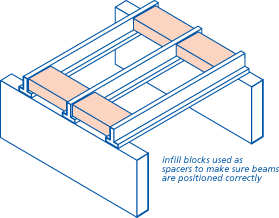
Beam layout drawings should always be followed. Doubled beams usually support concentrated loads, such as partitions.
Where floors rely on structural topping or in-situ make-up sections, propping may be needed until the in-situ concrete has reached its design strength.
Most precast floors rely on a grout to ensure composite action of the units and provide adequate strength, as well as fire and sound resistance.
The manufacturer's specification should be checked for the grout mix.
Restraint straps should be shown on the drawings. They are usually necessary where the beams run parallel with the wall.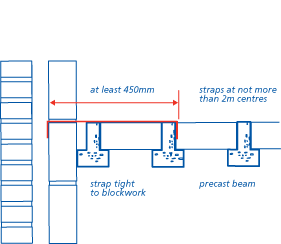
Metal ties may be required to provide a structural link across internal and separating walls.
Where holes are required for services, blocks should be omitted or cut where necessary. Infill blocks should be cut carefully and neatly without damage. Using a hammer and bolster to cut blocks may cause significant damage.
Large openings for staircases and chimneys may require openings to be trimmed. Specifications and drawings should be followed.
Steel trimmer shoes may be used to trim openings.
Doubled beams are common around trimmed openings, and should be propped until all voids have been solidly concreted and the concrete has reached its design strength.
Beams, planks or infill blocks that are cracked should not be used.
Some designs include metal ceiling clips inserted between the planks or blocks so that timber battens can be fixed below.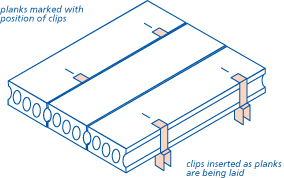
FIRE-STOPPING
The specified method of fire-stopping should be carried out. There should be no holes or gaps for smoke to penetrate once the fire-stopping has been installed. Where downlighters are incorporated in a ceiling they should be installed in accordance with the manufacturer's instructions





















